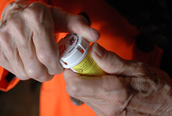One of the films in the famous Star Wars trilogy was The Empire Strikes Back. Keep this in mind as we embark upon my story of: Serotonin and the Synaptic Sea.
 “Serotonin is the neurochemical most often implicated in mood regulation. Cell bodies within our brains make it for us, and after it’s manufactured, to do us any good, it has to get somewhere. But first, it has to get moving. Pushed by a wave of chemical and electrical impulses, it travels through a fibrous tube (axon) and is deposited in little storage tanks (pre-synaptic vesicles) before its real work begins. Its journey begins when these storage tanks dump it into the synaptic sea (synaptic cleft). It then sails the synaptic sea in search of docking stations (post-synaptic receptors). Serotonin’s appointed duty is to influence these tiny proteins (receptors) by activating them or inhibiting them. After doing so, it is transported back (reuptake) for repackaging and is recycled, awaiting another journey.”
“Serotonin is the neurochemical most often implicated in mood regulation. Cell bodies within our brains make it for us, and after it’s manufactured, to do us any good, it has to get somewhere. But first, it has to get moving. Pushed by a wave of chemical and electrical impulses, it travels through a fibrous tube (axon) and is deposited in little storage tanks (pre-synaptic vesicles) before its real work begins. Its journey begins when these storage tanks dump it into the synaptic sea (synaptic cleft). It then sails the synaptic sea in search of docking stations (post-synaptic receptors). Serotonin’s appointed duty is to influence these tiny proteins (receptors) by activating them or inhibiting them. After doing so, it is transported back (reuptake) for repackaging and is recycled, awaiting another journey.”
This is the natural order of the biochemical process associated with mood regulation for all of us. And it doesn’t like to be messed with. Let me explain:
Approximately 10 percent of the adult population uses antidepressants, and their use in children and adolescents is increasing at a substantial rate. With this in mind, let’s harken back to our little serotonin fable above. An antidepressant’s primary role is to block the reuptake of serotonin into pre-synaptic cells forcing this neurotransmitter to remain in synaptic sea longer. I’m sure you get the “drift” here. The longer serotonin can remain in the synaptic cleft, the greater the possibility it can do its thing at the docking stations (receptors). Sounds good in theory, but multiple bodies of well-respected clinical work tell us that the Empire (brain) doesn’t take too kindly to such manipulation. And as such, it strikes back. Here’s how: perturbed by this artificial manipulation, the brain undergoes a series of compensatory mechanisms in an effort to maintain the normal functioning sequence that I outlined earlier. To get a little fancier, the brain seeks to restore its “homeostatic balance” or equilibrium. (There’s nothing at all unusual about this; every system in the universe seeks to do the same thing after getting out of kilter for a while.) And here’s what the brain does: armed with feedback forces, presynaptic nerve cells begin releasing less serotonin than usual, and in lockstep, the density level of the docking stations (post-synaptic receptors) diminishes. In simple terms, there are less of them. So as the antidepressant tries to continue accelerating serotonin activity, the brain responds by putting the hammer down. Wanna guess who wins?
The takeaway here: On-going use of an antidepressant may promote depression, not remit it. In the early 1990s, only 10-15 percent of people with major depression progressed to chronicity – becoming treatment-resistant. Today, 40 percent or more are treatment-resistant. Coincidentally, SSRI use exploded from the early 1990s to present. To make matters worse, this compensatory process often develops in people who had a satisfactory initial response to an antidepressant, and therefore continued to take the drug. Eighty percent of those maintained on an antidepressant experience symptom re-occurrence, and the longer people use them the greater the risk of relapse. So through treatment, they get worse.
For years now, I have been reporting in my blog space and in my seminars that the vast majority of my patients using antidepressants report a “plateauing” effect, particularly those using these agents for mild to moderate depression or dysthymia – for which they’re not indicated! And my concern through these many years has been that persistent use promotes resistance. Antidepressants are to mental health medicine what antibiotics are to physical medicine – when it comes to overuse. More is not more, so it is best that antidepressant users realign their expectations, and that prescribers reinforce the limitations of these drugs when it comes to what users want from them. Think months of use – not years.
To resurrect the tagline from a popular 1970s TV commercial for Chiffon margarine, “It’s not nice to fool Mother Nature!”





Leave A Comment
You must be logged in to post a comment.